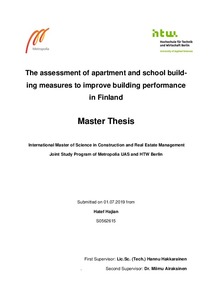Building stock-level life cycle carbon assessment on strategies of cities in the temperate climate zone : a case study of residential buildings in Lahti and Tampere, Finland
Jayawardana, Ashan Sanjith (2024)
Jayawardana, Ashan Sanjith
2024
All rights reserved. This publication is copyrighted. You may download, display and print it for Your own personal use. Commercial use is prohibited.
Julkaisun pysyvä osoite on
https://urn.fi/URN:NBN:fi:amk-2024100726141
https://urn.fi/URN:NBN:fi:amk-2024100726141
Tiivistelmä
This research aims to explore the pivotal role of decarbonising the existing building stock to reach national Greenhouse Gas Emissions (GHG) and resource consumption targets. In Europe alone, the building sector consumes 50% of all materials and generates more than one-third of all waste. Given that over 85% of current buildings are expected to remain in use by 2050, there is a research gap in exploring the whole life carbon emission (WLC) implications of existing stock, as opposed to the current narrow focus on operational emissions. Therefore, a comprehensive WLC analysis for residential buildings in the temperate climate zone was performed in this study, using Lahti and Tampere cities from Finland as case studies. Phase 01 involved analysing the existing Finnish building stock focusing on Lahti and Tampere, supplemented by national level data, which revealed that residential buildings is the most impactful building typology for life cycle carbon reduction, particularly Detached Houses (DH) and Block of Flats (BOF). Further analysis identified a demolition trend which shows that residential buildings from 1960-1990 are most likely to be demolished between 2030-2040, based on the demolition data and typical lifespan of a building in Finland. Considering this demolition trend and the most critical residential building typologies, six simplified archetypes were developed for WLC analysis in Phase 02. WLC of block of flats archetypes were 50% lower than the WLC values of detached houses archetypes. Hotspot mapping identified critical buildings for immediate intervention, based on the WLC and the probability for a building to be demolished. In Phase 03, WLC analysis was conducted for archetypes under two scenarios- renovation and reconstruction - which showed that renovations of DH and BOF have 23-28% and 40-52% lower WLC values respectively than reconstruction of the same buildings corresponding with their respective archetypes. The findings further indicated that renovation was more favourable for achieving carbon targets, due to lower Upfront Carbon spikes compared to new constructions. New DH emits almost 30% (avg. 28 tCO2e) of total CO2 emissions during the initial stages and that is almost 50% (avg. 840 tCO2e) for new BOF. Renovated buildings emit only around 8% of the total CO2 emission at the initial stages (DH- avg. 6.8 tCO2e and BOF-avg. 77 tCO2e). This research presents a replicable methodology for conducting macro scale (city level/ national level) whole life cycle carbon analysis, to communicate the advantages of renovations towards meeting climate goals.
Kokoelmat
Samankaltainen aineisto
Näytetään aineisto, joilla on samankaltaisia nimekkeitä, tekijöitä tai asiasanoja.
-
Sustainable Buildings for the High North. Energy performance, technologies and challenges of new buildings in Russia and Scandinavia
Sirviö, Anu; Illikainen, Kimmo
ePooki - Oulun ammattikorkeakoulun tutkimus- ja kehitystyön julkaisut 26/2015 (Oulun ammattikorkeakoulu, 2015)Since 2019 and 2021 energy performance of nearly zero energy level is required from new residential and non-residential buildings by Energy Performance of Buildings Directive (EPBD). Currently, building sector consumes ... -
The assessment of apartment and school building measures to improve building performance in Finland
Hajian, Hatef (2019)There are several tasks which are performed by buildings. These are usually referred to as building functions. The building performance is a characteristic of a structure that demonstrates how well the construction performs ... -
Green buildings in Russia, environmental classification of buildings
Martianov, Vitalii (Saimaan ammattikorkeakoulu, 2016)The aim of this thesis was to investigate and identify what part green construction takes in the world’s construction industry and what green construction standards exist. This topic is actual, as all community is interested ...



